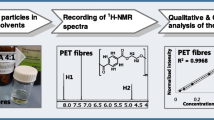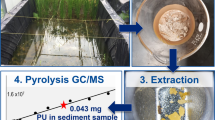Abstract
Identification and quantification of microplastics (MP) in environmental samples is crucial for understanding the risk and distribution of MP in the environment. Currently, quantification of MP particles in environmental samples and the comparability of different matrices is a major research topic. Research also focusses on sample preparation, since environmental samples must be free of inorganic and organic matrix components for the MP analysis. Therefore, we would like to propose a new method that allows the comparison of the results of MP analysis from different environmental matrices and gives a MP concentration in mass of MP particles per gram of environmental sample. This is possible by developing and validating an optimized and consistent sample preparation scheme for quantitative analysis of MP particles in environmental model samples in conjunction with quantitative 1H-NMR spectroscopy (qNMR). We evaluated for the first time the effects of different environmental matrices on identification and quantification of polyethylene terephthalate (PET) fibers using the qNMR method. Furthermore, high recovery rates were obtained from spiked environmental model samples (without matrix ~ 90%, sediment ~ 97%, freshwater ~ 94%, aquatic biofilm ~ 95%, and invertebrate matrix ~ 72%), demonstrating the high analytical potential of the method.

Graphical abstract





Similar content being viewed by others
Change history
18 November 2019
The original version of this article contained a mistake.
References
World Economic Forum. The New Plastics Economy: Rethinking the future of plastics. 2016. https://www.ellenmacarthurfoundation.org/publications/the-new-plastics-economy-rethinking-the-future-of-plastics. Accessed 6 Mar 2019.
Geyer R, Jambeck JR, Law KL. Production, use, and fate of all plastics ever made. Sci Adv. 2017;3:e1700782.
Moore CJ, Moore SL, Leecaster MK, Weisberg SB. A comparison of plastic and plankton in the North Pacific central gyre. Mar Pollut Bull. 2001;42:1297–300.
Wagner M, Scherer C, Alvarez-Munoz D, Brennholt N, Bourrain X, Buchinger S, et al. Microplastic in freshwater ecosystems: what we know and what we need to know. Environ Sci Eur. 2014;26:12.
Thompson RC, Olsen Y, Mitchell RP, Davis A, Rowland SJ, John Anthony WG, et al. Lost at sea: where is all the plastic? Science. 2004;304:838.
Thompson RC, Moore CJ, Vom Saal FS, Swan SH. Plastics, the environment and human health: current consensus and future trends. Philos Trans R Soc B. 2009;364:2153–66.
Wagner M, Lambert S, editors. Freshwater microplastics: emerging environmental contaminants? SpringerOpen. 2018.
Wright SL, Thompson RC, Galloway TS. The physical impacts of microplastics on marine organisms: a review. Environ Pollut. 2013;178:483–92.
Klein S, Worch E, Knepper TP. Occurrence and spatial distribution of microplastics in river shore sediments of the Rhine-Main area in Germany. Environ Sci Technol. 2015;49:6070–6.
Eerkes-Medrano D, Thompson RC, Aldridge DC. Microplastics in freshwater systems: a review of the emerging threats, identification of knowledge gaps and prioritisation of research needs. Water Res. 2015;75:63–82.
Derraik JGB. The pollution of the marine environment by plastic debris: a review. Mar Pollut Bull. 2002;44:842–52.
Ziajahromi S, Kumar A, Neale PA, Leusch FDL. Impact of microplastic beads and fibers on waterflea (Ceriodaphnia dubia) survival, growth, and reproduction: implications of single and mixture exposures. Environ Sci Technol. 2017;51:13397–406.
Wendt-Potthoff K, Imhof HK, Wagner M, Primpke S, Fischer D, Scholz-Böttcher BM, Laforsch C. Mikroplastik in Binnengewässern. Handbuch Angewandte Limnologie. 2017.
Käppler A, Fischer D, Oberbeckmann S, Schernewski G, Labrenz M, Eichhorn K-J, et al. Analysis of environmental microplastics by vibrational microspectroscopy: FTIR, Raman or both? Anal Bioanal Chem. 2016;408:8377–91.
Mai L, Bao L-J, Shi L, Wong CS, Zeng EY. A review of methods for measuring microplastics in aquatic environments. Environ Sci Pollut Res Int. 2018;25:11319–32.
Sanchez W, Bender C, Porcher J-M. Wild gudgeons (Gobio gobio) from French rivers are contaminated by microplastics: preliminary study and first evidence. Environ Res. 2014;128:98–100.
Ivleva NP, Wiesheu AC, Niessner R. Microplastic in aquatic ecosystems. Angew Chem Int Ed. 2017;56:1720–39.
Hidalgo-Ruz V, Gutow L, Thompson RC, Thiel M. Microplastics in the marine environment: a review of the methods used for identification and quantification. Environ Sci Technol. 2012;46:3060–75.
Imhof HK, Schmid J, Niessner R, Ivleva NP, Laforsch C. A novel, highly efficient method for the separation and quantification of plastic particles in sediments of aquatic environments. Limnol Oceanogr Methods. 2012;10:524–37.
Dris R, Imhof H, Sanchez W, Gasperi J, Galgani F, Tassin B, et al. Beyond the ocean: contamination of freshwater ecosystems with (micro-) plastic particles. Environ Chem. 2015;12:539–50.
Vandermeersch G, van Cauwenberghe L, Janssen CR, Marques A, Granby K, Fait G, et al. A critical view on microplastic quantification in aquatic organisms. Environ Res. 2015;143:46–55.
Löder MGJ, Imhof HK, Ladehoff M. Enzymatic purification of microplastics in environmental samples. Environ Sci Technol. 2017;51:14283–92.
Peez N, Janiska M-C, Imhof W. The first application of quantitative 1H-NMR-spectroscopy as a simple and fast method of identification and quantification of microplastic particles (PE, PET and PS). Anal Bioanal Chem. 2019;411:823–33.
Alves Filho EG, Silva LMA, Araújo NVP, Alves EG, Lião LM, Alcantara GB. Qualitative and quantitative control of pediatric syrups using nuclear magnetic resonance and chemometrics. J Pharm Biomed Anal. 2018;153:29–36.
Imhof HK, Ivleva NP, Schmid J, Niessner R, Laforsch C. Contamination of beach sediments of a subalpine lake with microplastic particles. Curr Biol. 2013;23:R867–8.
Monakhova Y, Diehl B. Practical guide for selection of 1H qNMR acquisition and processing parameters confirmed by automated spectra evaluation. Magn Reson Chem. 2017:996–1005.
Bharti SK, Roy R. Quantitative 1H NMR spectroscopy. TrAC. 2012;35:5–26.
Barding G, Salditos R, Larive C. Quantitative NMR for bioanalysis and metabolomics. Anal Bioanal Chem. 2012;404:1165–79.
Elert AM, Becker R, Duemichen E, Eisentraut P, Falkenhagen J, Sturm H, et al. Comparison of different methods for MP detection: what can we learn from them, and why asking the right question before measurements matters? Environ Pollut. 2017;231:1256–64.
Fischer M, Scholz-Böttcher BM. Simultaneous trace identification and quantification of common types of microplastics in environmental samples by pyrolysis-gas chromatography–mass spectrometry. Environ Sci Technol. 2017;51:5052–60.
Dümichen E, Barthel A-K, Braun U, Bannick CG, Brand K, Jekel M, et al. Analysis of polyethylene microplastics in environmental samples, using a thermal decomposition method. Water Res. 2015;85:451–7.
Silva AB, Bastos AS, Justino CIL, da Costa JP, Duarte AC, Rocha-Santos TAP. Microplastics in the environment: challenges in analytical chemistry - a review. Anal Chim Acta. 2018;1017:1–19.
Catarino AI, Thompson R, Sanderson W, Henry TB. Development and optimization of a standard method for extraction of microplastics in mussels by enzyme digestion of soft tissues. Environ Toxicol Chem. 2017;36:947–51.
Caron AGM, Thomas CR, Berry KLE, Motti CA, Ariel E, Brodie JE. Validation of an optimised protocol for quantification of microplastics in heterogenous samples: a case study using green turtle chyme. MethodsX. 2018;5:812–23.
Ceccarini A, Corti A, Erba F, Modugno F, La Nasa J, Bianchi S, et al. The hidden microplastics: new insights and figures from the thorough separation and characterization of microplastics and of their degradation byproducts in coastal sediments. Environ Sci Technol. 2018;52:5634–43.
Avio CG, Gorbi S, Regoli F. Experimental development of a new protocol for extraction and characterization of microplastics in fish tissues: first observations in commercial species from Adriatic Sea. Mar Environ Res. 2015;111:18–26.
Claessens M, van Cauwenberghe L, Vandegehuchte MB, Janssen CR. New techniques for the detection of microplastics in sediments and field collected organisms. Mar Pollut Bull. 2013;70:227–33.
Zhao S, Zhu L, Gao L, Li D (eds). Limitations for microplastic quantification in the ocean and recommendations for improvement and standardization. Microplatic Contamination in Aquatic Environments: Elsevier Inc. 2018.
Nuelle M-T, Dekiff JH, Remy D, Fries E. A new analytical approach for monitoring micrplastics in marine sediments. Environ Pollut. 2014;184:161–9.
Fries E, Dekiff JH, Willmeyer J, Nuelle M-T, Ebert M, Remy D. Identification of polymer types and additives in marine microplastic particles using pyrolysis-GC/MS and scanning electron microscopy. Environ Sci: Processes Impacts. 2013;15:1949–56.
Nor NHM, Obbard JP. Microplastics in Singapore's coastal mangrove ecosystems. Mar Pollut Bull. 2014;79:278–83.
Stolte A, Forster S, Gerdts G, Schubert H. Microplastic concentrations in beach sediments along the German Baltic coast. Mar Pollut Bull. 2015;99:216–29.
Hurley RR, Lusher AL, Olsen M, Nizzetto L. Validation of a method for extracting microplastics from complex, organic-rich, environmental matrices. Environ Sci Technol. 2018;52:7409–17.
Hanvey JS, Lewis PJ, Lavers JL, Crosbie ND, Pozo K, Clarke BO. A review of analytical techniques for quantifying microplastics in sediments. Anal Methods. 2017;9:1369–83.
Acknowledgments
The authors thank Prof. Dr. B. Hahn and M. Albanna (University of Applied Science, RheinAhrCampus, Remagen, Germany) for SEM support. Furthermore, we thank Lana Vuleta for proofreading.
Funding
The authors gratefully acknowledge the financial support of the Deutsche Forschungsgemeinschaft (INST 366/6-1) for the purchase of the NMR spectrometer. The authors also acknowledge financial support of the research fund of University Koblenz - Landau.
Author information
Authors and Affiliations
Corresponding author
Ethics declarations
Conflict of interest
The authors declare that they have no competing interests.
Additional information
Publisher’s note
Springer Nature remains neutral with regard to jurisdictional claims in published maps and institutional affiliations.
The original version of this article was revised: The word “sediment” 20 was accidentally removed in Figure 5 due to a technical error.
Electronic supplementary material
ESM 1
(PDF 428 kb)
Rights and permissions
About this article
Cite this article
Peez, N., Becker, J., Ehlers, S.M. et al. Quantitative analysis of PET microplastics in environmental model samples using quantitative 1H-NMR spectroscopy: validation of an optimized and consistent sample clean-up method. Anal Bioanal Chem 411, 7409–7418 (2019). https://doi.org/10.1007/s00216-019-02089-2
Received:
Revised:
Accepted:
Published:
Issue Date:
DOI: https://doi.org/10.1007/s00216-019-02089-2




